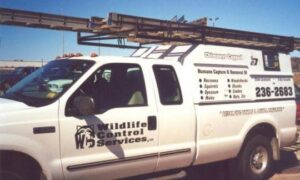
Photo credit: Stephen Vantassel
Landowners with limited wildlife experience can easily handle some problems. For example, it is simple and effective to set a snap-trap in a kitchen cabinet to catch a mouse eating stored foods. Additionally, netting can be placed over fruit trees or bushes to protect them from damage caused by fruit-eating birds. However, there are times when wildlife issues are much more complex and require professional skills or training. The following list provides examples of situations where professional expertise is needed.
- Rabies-vector species– Bats, raccoons, foxes, skunks, and coyotes are rabies-vector species and are more likely to transmit this disease to people or pets. These species should only be handled by wildlife professionals who have received rabies pre-exposure immunization.
- High-risk situations– Repairing damaged building soffits or chewed electrical wires is beyond the skill level of most homeowners. It makes sense to contact a professional with the appropriate tools, personal protective equipment (PPE), and experience to complete the job safely and correctly.
- Animals that are difficult to handle – No one wants to be sprayed by a skunk or deal with a messy clean-up. In such situations, it is best to contact a professional who understands skunk behavior and can catch the animal while reducing the likelihood of spraying. Additionally, catching coyotes or foxes requires specialized skills in setting traps, and the captured animals must be handled humanely. There are many similar situations where professional expertise is needed.
- Pesticide applications– Sometimes, situations are most quickly resolved with the effective use of registered pesticides. Certified pesticide applicators are trained to use effective toxicants and repellents properly, while also selecting low-risk products. For example, toxic rodent baits must be placed appropriately to minimize the poisoning of non-target species. The skills and experiences of licensed professionals should be considered when pesticide applications are required.
- Site-specific considerations– Some sites pose unique wildlife management challenges. For example, catching and removing birds from a public location, such as a mall, would require different methods and preparation than removing a starling from an attic. Public perceptions, visibility, and risk must be considered when evaluating different sites and control methods. Professionals should be consulted when dealing with wildlife in sensitive sites or situations.
- Animal disposition– Many nuisance wildlife species can be easily trapped alive, but then, what do you do with the critter? Before ever setting a trap, you need a plan for humanely dealing with whatever animal might be caught. Most homeowners either do not want to or have the expertise to euthanize a problem animal humanely. In some states, it is illegal to transport live animals off your property. Professional wildlife control operators are trained to dispose of unwanted pests humanely. In cases where healthy animals can be translocated, the license may allow for off-site transport and release.
The information on this webpage is based on the contents of the Wildlife Control Operator Core Training Manual published by the National Wildlife Control Training Program.